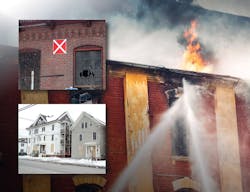Arson Awareness Week Focuses on Vacant Buildings
The U.S. Fire Administration is turning its focus for this year's Arson Awareness Week toward vacant and abandoned buildings—an issue which may hit a bit closer to home for a majority of firefighters than other topics in recent years.
While the USFA's prevention focus on vehicle arson (2014), wildfire arson (2016) and arson at houses of worship (2017) are all important issues worthy of education and training, the organization says arson fires at vacant and abandoned buildings cause a disproportionate share of firefighter injuries.
"Vacant and abandoned buildings have a negative impact on a community’s image," says the USFA, which launches Arson Awareness Week on May 6. "Their presence may result in an increase of criminal activity and public safety problems."
According to USFA statistics, about 23,800 vacant residential building fires are reported every year and cause an estimated 75 deaths, 200 injuries and upward of $785 million in property loss. The numbers for vacant non-residential structures are smaller but no less significant: 6,400 fires reported each year, causing an estimated five deaths, 50 injuries and $205 million in losses.
Amid the weight of such glaring statistics, the USFA is providing a wealth of materials for both firefighters and arson investigators, as well as community risk reduction tools to help residents and local government officials better manage the many issues that surround such buildings.
Tools for firefighters include some basic evaluation procedures for vacant or abandoned buildings to determine if they are secure and to identify any hazards. Evaluation methods primarily concern the fire growth potential of the structure and any potential for collapse.
"Personnel conducting evaluations on vacant and abandoned properties should be aware that these structures are inherently more dangerous than occupied properties," the USFA says.
The USFA encourages any fire investigators seeking specialized training on vacant and abandoned buildings to visit The International Association of Arson Investigators’ (IAAI) Certified Fire Investigator Trainer website, where they can learn the characteristics of these structures, the challenges in probing fires involving them, and how to conduct a safe and successful investigation.
The National Fire Academy also provides several training courses on conducting investigations.
As far as what the public and community leaders can do to help prevent arson at vacant and abandoned buildings, the USFA points to four essential components:
- Monitor: Properties that are secure and well-maintained, though unoccupied, do not pose the same type of risk as unsecured properties which are accessible to unauthorized entry. These latter properties require immediate attention.
- Secure: Preventing unauthorized access to vacant and abandoned buildings through proper security or high visibility surveillance can make all the difference since 72 percent of fires in these structures are incendiary or suspicious in origin.
- Inspect: Evaluating these buildings to identify potential safety issues for firefighters or first responders relies on a community's particular codes and ordinances, making it vital for inspectors to understand their department's policies on when they can legally enter a structure.
- Mark: Marking vacant or abandoned buildings after they have been inspected provides a vital visual cue for firefighters. A red box with an X means only exterior operations should be performed unless there is a known life hazard, while a red box with a single line means interior ops should be handled with extreme caution. An empty red box denotes normal structural stability at the time of marking.
The USFA is also raising awareness on the new method of "clear boarding," which is a safer alternative to using plywood to shore up windows and doors on these structures, and it allows law enforcement and first responders to get a clear look to determine if there are squatters or criminal activities inside.
Residents and firefighters utilizing these tools and techniques to monitor and secure vacant and abandoned buildings in and around their communities can go a long way toward reducing the risk of arson fires and save lives.
"Take the time to learn your community," National Fire Academy Superintendent Tonya Hoover said on recent a CFI Trainer podcast. "Take the time to find vacant buildings and have situational awareness ... just in case our emergency responders should have a call to those vacant buildings."
